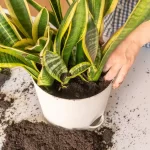Creating an appropriate environment is essential for the successful growth and well-being of rattlesnake plants (Calathea lancifolia). These tropical plants display unique foliage patterns and vibrant colors, making them popular choices for indoor gardening. This essay will provide a comprehensive guide on how to create the right environment for rattlesnake plants, including lighting, temperature, humidity, watering, and soil conditions.
What Is a Rattlesnake Plant
The rattlesnake plant (Goeppertia insignis syn. Calathea lancifolia) is an evergreen perennial plant in the Marantaceae family native to the rainforests of Brazil. This foliage plant has long, pointed leaves with scaly, variegated patterns reminiscent of a rattlesnake. Its leaves are narrower than many other calathea, with dark and light green colors, wavy edges, and purple undersides.
The leaves of this plant fold up at night and open during the day, similar to the prayer plant. They are popular indoor plants due to their compact growth habit (reaching heights of two feet) and high humidity requirements. They are also non-toxic to humans and animals. Rattlesnake plants rarely bloom indoors, but they may sprout small, yellow flowers when you plant them outdoors. They thrive best in USDA Hardiness Zones eleven to twelve.
When to Plant Rattlesnake Plant
You can plant rattlesnake plants at any time of year when you plant them inside as potted plants, which is advisable since they are humidity-loving specimens that are not frost tender. Plant rattlesnake plants indoors when there is plenty of natural, indirect sunlight. For most climates, this is during the spring and summer months.
Tips for Creating A Right Environment

Lighting
- Indirect Sunlight: Rattlesnake plants thrive in bright but indirect sunlight. Place them near a north or east-facing window where they can receive gentle morning or evening sunlight. Direct sunlight can scorch the leaves, so it is important to avoid placing them in direct exposure to intense sunlight.
- Shading: If the available natural light is too intense or the plant is near a window with direct sunlight, provide some shading. This can be achieved by using sheer curtains or placing the plant slightly away from the window to diffuse the light.
Temperature
- Ideal Temperature Range: Rattlesnake plants prefer a warm and consistent temperature. Aim to keep the temperature between 60-75°F (15-24°C) during the day and slightly cooler at night. Drastic temperature fluctuations should be avoided, as they can cause stress and affect the plant’s growth.
- Avoid Drafts: Position the rattlesnake plant away from drafts or areas with constant temperature changes, such as near windows, doors, or air vents. Drafts can cause temperature fluctuations that are detrimental to the plant’s health.
Humidity
- Increase Humidity Levels: Rattlesnake plants are native to tropical regions with high humidity. To create an ideal environment, increase humidity levels around the plant. Use methods such as placing the pot on a tray filled with water and pebbles or using a room humidifier. These techniques help to create a microclimate that replicates the plant’s natural habitat.
- Regular Misting: Mist the leaves of the rattlesnake plant regularly with water. This additional moisture helps to increase humidity and keeps the foliage clean, preventing the buildup of dust that can hinder photosynthesis.
Watering
- Moist but Not Soggy: Maintain slightly moist soil for rattlesnake plants, avoiding both overwatering and underwatering. Allow the top inch of soil to dry out before watering again. Check the moisture level by inserting a finger into the soil. If it feels dry, it is time to water the plant.
- Quality of Water: Use room temperature, filtered water to avoid chlorine and other harmful chemicals that may be present in tap water. Rattlesnake plants are sensitive to impurities, and using filtered water can help maintain their overall health.
Soil Conditions
- Well-Draining Soil: Rattlesnake plants require well-draining soil to prevent waterlogging and root rot. Use a high-quality potting mix that is specifically formulated for tropical plants or create a suitable mix by combining equal parts of peat moss, perlite, and coco coir.
- Organic Matter: Incorporate organic matter, such as compost or well-rotted manure, into the potting mix. This improves soil fertility and provides essential nutrients for the rattlesnake plant’s growth.
Common Problems With Rattlesnake Plants

Leaf Browning or Curling
One common issue with rattlesnake plants is leaf browning or curling. This can be caused by low humidity levels, exposure to direct sunlight, or underwatering. To address this problem, increase humidity by misting the leaves regularly or using a room humidifier. Ensure the plant is placed in a location with indirect sunlight, and adjust watering practices to keep the soil slightly moist.
Yellowing Leaves
Yellowing leaves on a rattlesnake plant can be a sign of overwatering or poor drainage. Excessive moisture can lead to root rot and nutrient deficiencies, causing the leaves to turn yellow. To resolve this issue, adjust the watering schedule to allow the top inch of soil to dry out before watering again. Check the plant’s drainage by ensuring the pot has proper drainage holes and using well-draining soil.
Pest Infestations
Rattlesnake plants can attract common houseplant pests such as spider mites, mealybugs, and aphids. These pests can cause damage to the leaves and hinder the plant’s growth. To tackle pest infestations, regularly inspect the plant for signs of pests, such as small webs, sticky residue, or visible insects. Use organic or chemical pest control methods to eliminate the pests, ensuring to follow the instructions on the product label.
Fungal Leaf Spot
Fungal leaf spots can appear as dark brown or black spots on the leaves of rattlesnake plants. This is often caused by overwatering or high humidity levels, providing a favorable environment for fungal growth. To prevent this issue, adjust watering practices to avoid waterlogged soil and reduce humidity levels by improving airflow around the plant. If fungal leaf spot occurs, prune affected leaves and apply a fungicide according to the product instructions.
Slow Growth
Rattlesnake plants may exhibit slow growth if they do not receive adequate light, nutrients, or appropriate environmental conditions. Ensure the plant is placed in a location with bright, indirect light. Feed the plant with a balanced houseplant fertilizer every 4-6 weeks during the growing season to provide essential nutrients. Additionally, maintain optimal temperature and humidity levels to promote healthy growth.
Conclusion
Creating the right environment is paramount for the successful cultivation of rattlesnake plants. By ensuring appropriate lighting, maintaining optimal temperatures, increasing humidity levels, implementing proper watering techniques, and using well-draining soil, individuals can provide a suitable habitat for their rattlesnake plants to thrive. By following these guidelines, plant enthusiasts can enjoy the beauty and unique characteristics of rattlesnake plants in their indoor spaces.


